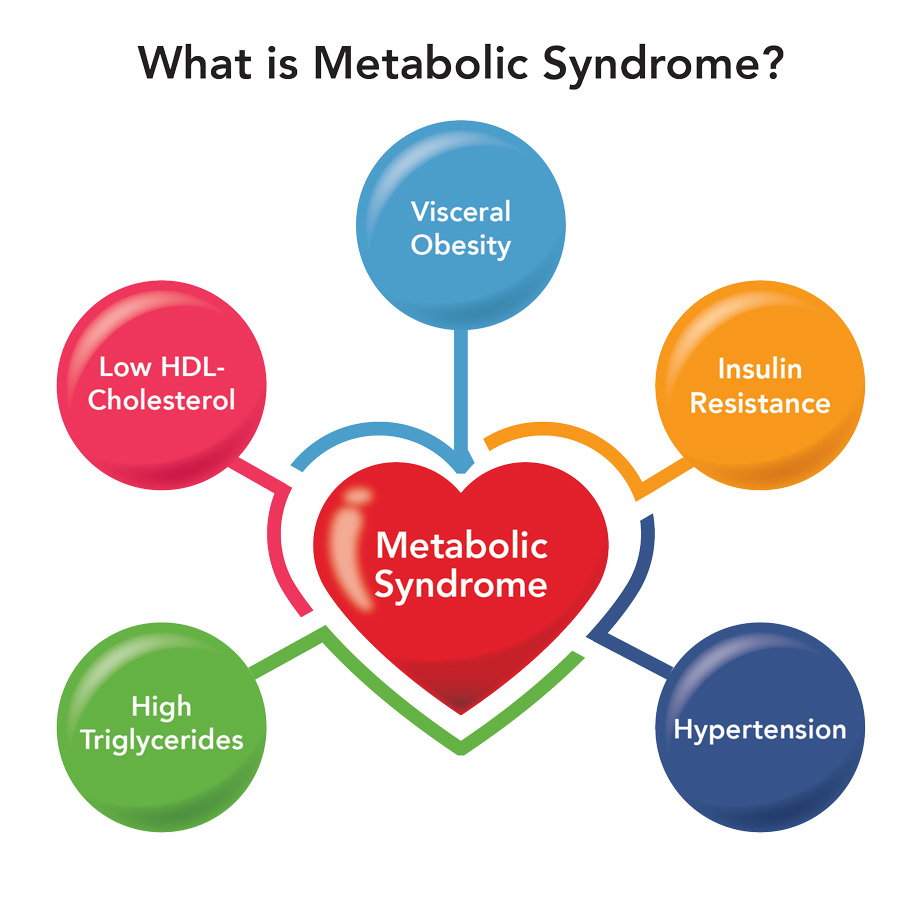
Obesity and Inflammation
Inflammation occurs in response to any kind of harmful stimulus. Think of when you get a scratch, the area around it becomes, warm, red, and inflamed. This is a good example of the inflammatory response. However, inflammation can also happen in the brain in response to potentially harmful stimuli. The brain, specifically the hypothalamus can become inflamed in response to overnutrition. This inflammation occurs within a few hours to three days after an overconsumption of glucose or lipids. Inflammation in the hypothalamus can lead to dysregulation of homeostasis. Because inflammation occurs before the onset of metabolic syndrome and related illnesses, it is believed to be a cause of those disorders. https://www.ncbi.nlm.nih.gov/pmc/articles/PMC4389774/#!po=6.19835
Metabolic Syndrome
Metabolic syndrome is a cluster of symptoms that lead to an increase in the risk of developing Type 2 Diabetes, Cardiovascular Disease, and stroke. The figure is a good graphic of what components are involved with metabolic syndrome. Having even one component of metabolic syndrome can increase your risk of development of a serious condition. About 1/3 of adults in the United States have metabolic syndrome. One of these components is critical in the hypothalamic inflammation that is seen in obesity, insulin signaling. https://www.mayoclinic.org/diseases-conditions/metabolic-syndrome/symptoms-causes/syc-20351916
symptoms that lead to an increase in the risk of developing Type 2 Diabetes, Cardiovascular Disease, and stroke. The figure is a good graphic of what components are involved with metabolic syndrome. Having even one component of metabolic syndrome can increase your risk of development of a serious condition. About 1/3 of adults in the United States have metabolic syndrome. One of these components is critical in the hypothalamic inflammation that is seen in obesity, insulin signaling. https://www.mayoclinic.org/diseases-conditions/metabolic-syndrome/symptoms-causes/syc-20351916
Insulin Signaling
https://www.ncbi.nlm.nih.gov/pubmed/28045396
Insulin resistance is a critical part of obesity and Type 2 Diabetes. When the body becomes resistant to insulin it no longer responds to insulin. The figure above focuses on insulin’s role in the activation of FOXO1. FOXO1 is critical for the activity of POMC neurons (more on that later) and when it is activated it no longer inhibits STAT. FOXO1 can be inhibited by the presence of saturated fatty acids and TNF. The figure also shows another role for saturated fatty acids, downstream activation of cytokines and a protein known as SOCS (suppression of cytokine signaling). This brings us back to the role of overnutrition in the inflammation response. The figure above also shows the role of leptin signaling. In obesity leptin signaling is also dysregulated. Normally leptin is repsonsible for the activation of POMC and the inhibition of AgRP. The last step of this signaling pathway involves STAT which can be inhibited by the inactivation of FOXO1. Obesity also manifests itself in leptin resistance. https://www.ncbi.nlm.nih.gov/pmc/articles/PMC2430504/
POMC and AgRP
AgRP neuron are regulated through leptin and insulin signaling pathways mentioned above. AgRP neurons are responsible for messages telling us to feed. When this control is lost through leptin resistance, the inhibition is lost and leads to overfeeding. The other half of this control system is the POMC neurons. These neurons are responsible for telling us not to eat. They can be activated by both insulin via FOXO1 and leptin signaling. When resistance to insulin and leptin occurs these neuron become less active. The third part of this diagram shows the importance of the balance between energy expenditure and food intake. When control of POMC and AgRP is loss food intake goes up and subsequently energy expenditure decreases. https://www.ncbi.nlm.nih.gov/pubmed/28045396
There are more pieces than what meets the eye involved in obesity. Once the original overnutrition occurs it triggers changes within the brain. This becomes a vicious cycle of overeating and physiological changes which can be difficult to break out of.

